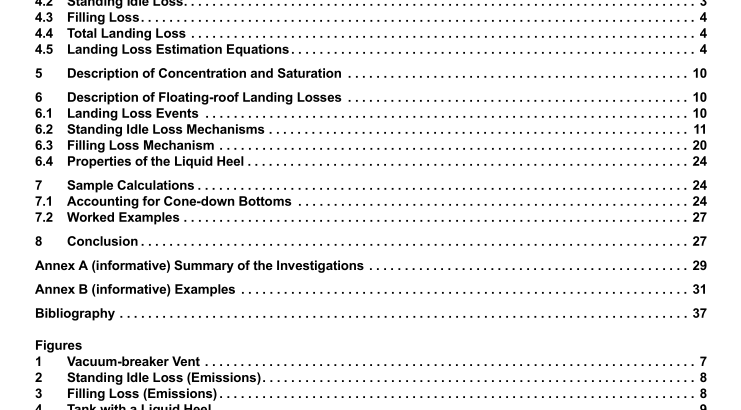API MPMS 19.6.1:2017 pdf free download.Manual of Petroleum Measurement Standards Chapter 19.6 Part 1—Evaporative Loss from Storage Tank Floating-roof Landings
6 Description of Floating-roof Landing Losses
6.1 Landing Loss Events The emissions associated with each episode of landing a floating roof and subsequently refilling the tank may be categorized as occurring in two distinct events. The first is driven by the evaporation of stock liquid that remains in the bottom of the tank while the floating roof is landed. This event shall be termed standing idle loss. The other event is the displacement of stock vapors from under the floating roof when the tank is refilled. This event shall be termed filling loss.
The total emissions for a given episode are then the sum of the standing idle loss and the filling loss for that episode. To estimate the annual emissions associated with floating-roof landings for a particular tank, the emissions would be summed from each of the floating-roof episodes that occurred that year. Any freely vented floating-roof tank would be expected to have landing losses if the floating roof is landed, regardless of whether the tank is an IFRT, EFRT, or a covered (domed external) floating-roof tank (CFRT). While the tank construction will influence the estimated magnitude of the landing losses, there is no difference in the emissions mechanisms for IFRTs versus CFRTs, and thus for purposes of this discussion CFRTs are included with IFRTs.
Given that floating-roof landing losses occur when a floating-roof tank has been emptied below the level that lands the floating roof, this emission episode does not occur if the floating roof is maintained in a floating condition, nor does it occur with a tank that does not have a floating roof.
6.2 Standing Idle Loss Mechanisms General
6.2.1 The loss mechanism assumed for standing idle loss in the 10/1/97 TGB report [15] was breathing of the vapor space under the floating roof. This mechanism involves the generation of vapors beneath the floating roof by evaporation of liquid remaining in the bottom of the tank and the subsequent daily expulsion of a portion of these vapors in response to the daytime rise in ambient temperature. As the ambient temperature rises and heats the tank, the vapors expand and a portion of them are pushed out of the vapor space. T
he vapors that remain beneath the floating roof are eventually all expelled by incoming liquid when the tank is refilled. Although these vapors are generated while the tank is standing idle, they are included with the filling loss rather than the standing idle loss. After subsequent consideration, it was concluded that the breathing mechanism model applies only to IFRTs with sufficient liquid remaining in the tank to continually replenish vapors lost by daily breathing (i.e. IFRTs with a liquid heel). The standing idle loss mechanism identified for EFRTs with a liquid heel is wind effects. When a liquid heel is not present because the tank has been drained virtually dry, then the standing idle loss mechanism appears to be the evaporation of the thin layer of liquid clinging to the bottom of the tank. This clingage mechanism applies to drain-dry operations for both internal and EFRTs. Internal Floating-roof Tanks with a Liquid Heel (Full or Partial) 6.2.2
6.2.2.1 General Standing idle losses from a landed internal floating roof with a liquid heel are modeled as a breathing phenomenon. The vapor space beneath the internal floating roof is assumed to behave in a manner similar to the headspace of a fixed-roof tank. The height of the vapor space beneath the floating roof is substituted for the vapor space outage in the calculation method published in API MPMS Chapter 19.1, where this phenomenon is termed standing loss.
6.2.2.2 Confidence in the Breathing Loss Model The equation used in this model is derived from the ideal gas laws and should be a reliable predictor of breathing loss when the variables are evaluated correctly. Required inputs for this equation include temperature data and characteristic saturation levels for given scenarios. The methodology presented in API MPMS Chapter 19.1 predicts the liquid surface and vapor space temperatures to be within a few degrees above ambient temperature, with the increase being due to solar insolation.API MPMS 19.6.1 pdf download.API MPMS 19.6.1:2017 pdf free download
